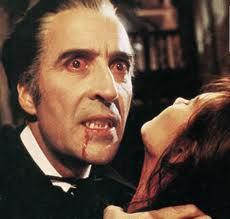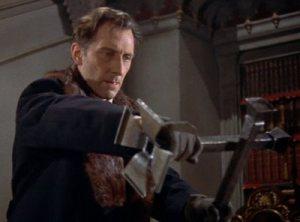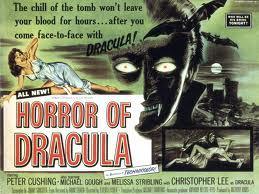This is the continuation of the history of Dracula as one of the most iconic figures in film history, the previous installments can be found; here, here, and here. The Cold War was beginning to heat up as the United States and the Soviet Union raced each other to see who could build the biggest arsenal of nuclear weapons. In Hollywood the powers that be sought to prey upon America’s newfound fear in the consequences of nuclear proliferation. In the previous era of film, Dracula led a whole host of literary monsters through gothic landscapes terrifying the populace. But now the monsters moviegoers wanted to see were giants and aliens who were a reflection of the world they now lived in. But all was not lost, in the United Kingdom a new movie studio had arisen to give gothic horror a new home, Hammer Film Productions. The studio had been experimenting with the genre and found great success with, The Curse of Frankenstein, which was helmed by Terence Fisher and featured two up and coming actors, Peter Cushing and Christopher Lee. Just as Universal Studios so many years before, they realized that the man-made monster and the undead Count went together, and their next foray into horror was, Dracula.
here, here, and here. The Cold War was beginning to heat up as the United States and the Soviet Union raced each other to see who could build the biggest arsenal of nuclear weapons. In Hollywood the powers that be sought to prey upon America’s newfound fear in the consequences of nuclear proliferation. In the previous era of film, Dracula led a whole host of literary monsters through gothic landscapes terrifying the populace. But now the monsters moviegoers wanted to see were giants and aliens who were a reflection of the world they now lived in. But all was not lost, in the United Kingdom a new movie studio had arisen to give gothic horror a new home, Hammer Film Productions. The studio had been experimenting with the genre and found great success with, The Curse of Frankenstein, which was helmed by Terence Fisher and featured two up and coming actors, Peter Cushing and Christopher Lee. Just as Universal Studios so many years before, they realized that the man-made monster and the undead Count went together, and their next foray into horror was, Dracula.
Bela Lugosi had become iconic in the role of Count Dracula by portraying the monster as very dashing and charming as a means to cover his evil nature. In order to differentiate himself Christopher Lee had to do something very different with the role, and the now legendary performer shed the charm and gave filmgoers a monster that was pure evil. Christopher Lee’s life was one that had all of the trappings of an intriguing tale already; during World War II he was a member of the elite Special Operations Executives and had worked with luminaries such as; John Huston and Douglas Fairbanks. This no doubt gave him a great sense of intrigue and experience that he was able to translate into the role giving the infamous vampire giving him a presence that he was an old soul trapped in a young body. In contrast to the eloquent dialog delivered via an East European accent as fans are accustomed to, Lee spoke only thirteen lines in the picture and let his mannerisms tell the story. By simply standing there Lee was able to convey a brilliatn sense of menace, mystery, and sexuality whiloe terrifying audiences. In order to achieve the fierce red eyes he brandished in the film, Lee wore contacts that were incredibly uncomfortable and actually prevented him from seeing anything which led to tales of accidents on the set. Another iconic element of Lee’s look in the role was that he was the first onscreen Dracula to brandish a set of fangs to tear about the flesh of his victims.

Fighting on the side of the good guys was Peter Cushing who like Lee would become forever associated with the horror genre. Edward Van Sloan may have been the first actor to play the vampire slayer on the silver screen, but it was Cushing who made the character an icon. With great gusto and charisma Cushing was not your father’s monster hunter, his interpretation character was more action hero than stout scholar and actually dared go toe-to-toe with Dracula. He would reprise this role numerous times and is recognized as the definitive Van Helsing in film.
In the previous era of horror films, Universal Studios prided themselves on melodramatic pieces with a gothic flair, but the Hammer foray into the genre had a much different feel, thanks in large part to their director Terence Fisher. Suddenly gothic horror films were fast-paced, violent, and developed a reputation for creative methods of killing characters. Fisher honed this style while directing Dracula, and it was most notable during the climax as Van Helsing and Dracula battled it out in the vampire’s castle. Fisher also takes advantage of color in a way that previous horror movie makers were unable to, and as a result Dracula was a feast for the eyes with beautiful sets filmed in eye popping technicolor. Was the cartoonish blood and gore that proliferated the movie, which shocked and delighted audiences.

The film was released in the spring of 1958 in the United States and the United Kingdom. Due to the fact that the 1931 version of the story was still being booked in theaters, Fisher’s movie was retitled Horror of Dracula for its American release. This entertaining retelling of the story was a huge success at the box office and the critics. Dracula proved once again that the character was still a bankable film character and Hammer went to work putting Cushing and Lee together for further sequels as the blood drinking count rose from the grave once more.

